This article includes a list of general references, but it lacks sufficient corresponding inline citations .(February 2019) |
![Evening Landscape on the Hintersee [de] with a View of the Hoher Goll Studer-Hintersee.png](http://upload.wikimedia.org/wikipedia/commons/thumb/8/80/Studer-Hintersee.png/325px-Studer-Hintersee.png)

Bernhard Studer (5 August 1832, Gunzgen - 22 April 1868, Munich) was a Swiss landscape painter.
This article includes a list of general references, but it lacks sufficient corresponding inline citations .(February 2019) |
![Evening Landscape on the Hintersee [de] with a View of the Hoher Goll Studer-Hintersee.png](http://upload.wikimedia.org/wikipedia/commons/thumb/8/80/Studer-Hintersee.png/325px-Studer-Hintersee.png)

Bernhard Studer (5 August 1832, Gunzgen - 22 April 1868, Munich) was a Swiss landscape painter.
His father, Leonz, was a house painter. [1] At the age of fourteen, he began to study drawing with a sculptor named Johann Georg Lüthy in Olten. After that, he returned to Solothurn and attended the drawing classes of Gaudenz Taverna. In 1850, following the advice of his teachers, he enrolled as a student at the Academy of Fine Arts, Munich. He also found work in the studios of the landscape painter, Carl Millner. After two years, financially difficulties compelled him to return home.
In 1853, with a student loan from the Canton of Solothurn, he was able to enroll at the Kunstakademie Düsseldorf, where he was first exposed to the Düsseldorf School of painting. He studied with Rudolf Wiegmann, Johann Wilhelm Schirmer and Hans Gude, all noted landscape painters. While there, he became a member of Malkasten, an artists' association. He remained at the Akademie until 1856, when he was dismissed for having an "unordentlichen Lebens" (disorderly, or unorthodox, life).
That same year, he went with his teacher, Schirmer, to the Academy of Fine Arts, Karlsruhe. During these times, he continued to exhibit in Switzerland and received a silver medal in Bern in 1857. He returned to Munich in 1865 and died there three years later, from what was officially ruled a "progressive lung disease".
He is mentioned in a biographical novel, "Hans Marbot", written by Erwin Friedrich Baumann. This book traces the life of Baumann's father Friedrich Baumann , a close friend of Studer's who was the subject of his only known portrait painting.
Many of his works are in private collections and an effort is underway to create a catalog raisonné.
The Academy of Fine Arts, Munich is one of the oldest and most significant art academies in Germany. It is located in the Maxvorstadt district of Munich, in Bavaria, Germany.
The Düsseldorf school of painting is a term referring to a group of painters who taught or studied at the Düsseldorf Academy during the 1830s and 1840s, when the Academy was directed by the painter Wilhelm von Schadow.

Eugen Gustav Dücker was a Baltic German painter, in the Romantic atyle, associated with the Düsseldorfer Malerschule.
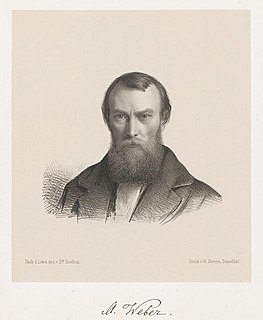
Johann Baptist Wilhelm August Weber was a German painter; associated with the Düsseldorfer Malerschule.
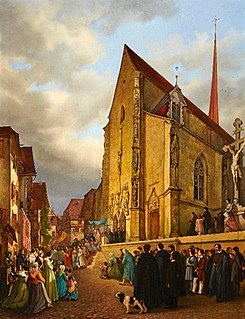
Anton Bütler, born Joseph Antonius Laurentius Bütler was a Swiss landscape, history and church painter.
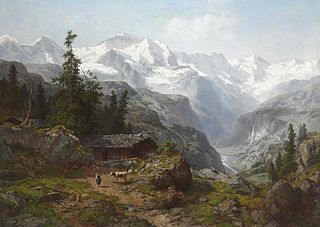
Joseph Niklaus Bütler, born Josephus Nicolaus Gallus Bütler was a Swiss landscape painter; associated with the Düsseldorfer Malerschule.

August Becker was a German landscape painter; associated with the Düsseldorfer Malerschule.

Johann Heinrich Carl Reinhold was a German painter and engraver.
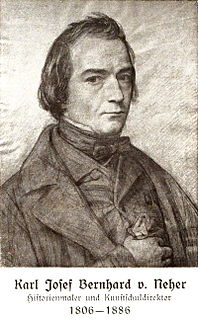
Karl Josef Bernhard von Neher was a German painter.

Julius Lange was a German landscape painter.
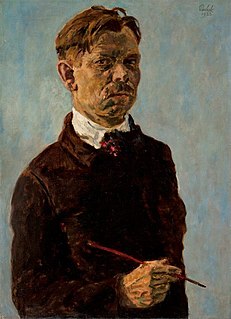
Bernhard Wilhelm Maria Pankok was a German painter, graphic artist, architect, and designer. His works are characterized by the transition between Art Nouveau and the International Style. His furniture and book design, such as the catalog for the German section of the Exposition Universelle (1900) in Paris, have garnered him the most recognition.

The State Academy of Fine Arts Stuttgart is a university in Stuttgart, Germany. Founded on 25 June 1761, and located since 1946 on the Weißenhof, the Academy, whose historical significance marks names such as Nicolas Guibal, Johann Heinrich von Dannecker, Bernhard Pankok, Adolf Hölzel, Willi Baumeister, Herbert Hirche, K.R.H. Sonderborg, Alfred Hrdlicka, Heinz Edelmann, Marianne Eigenheer, Richard Sapper, Joseph Kosuth, David Chipperfield, Joan Jonas, Micha Ullman, offers from all art universities in the federal state Baden-Württemberg the largest numbers of courses, namely all disciplines of the visual field, and not just in an organizational network but also under one roof. This is essentially the result of the connection of the former Academy of Fine Arts with the former School of Applied Arts in 1941 as Staatliche Akademie der bildenden Künste Stuttgart, which was reconstituted by Theodor Heuss in 1946 under the same name and which aimed at a broad training program as well as an intensified development in the following decades. Under the rectorate of Wolfgang Kermer, on 22 February 1975, the ″Gesetz über die Kunsthochschulen im Lande Baden-Württemberg (Kunsthochschulgesetz)″ passed by the Landtag of Baden-Württemberg came into force, which for the first time in the history of the State Academy of Fine Arts Stuttgart regulated the status and the essential relationships and which guaranteed the equality of rank with universities.

Count Stanislaus Friedrich Ludwig von Kalckreuth was a German painter who specialized in mountain landscapes.

Carl Jungheim was a German landscape painter, associated with the Düsseldorfer Malerschule.
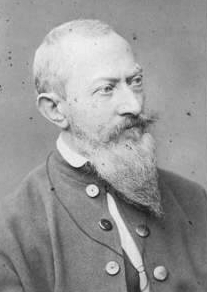
Johann Friedrich Andreas Heimerdinger was a German painter; specializing in still-lifes.
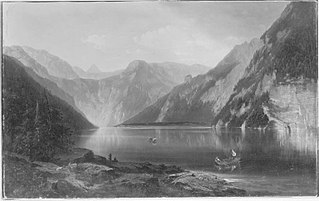
Carl Waagen was a German painter and lithographer.
Carl (Karl) Adloff was a German painter of the Düsseldorf school of painting.
Carl Ernst Bernhard Jutz, also Carl Jutz der Jüngere was a German landscape painter of the Düsseldorf school of painting.
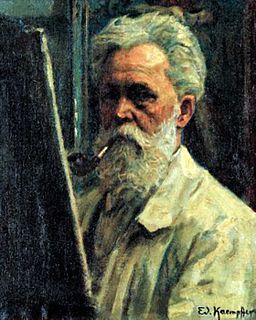
Eduard Kaempffer was a German painter, sculptor and medallist.

Otto Knille was a German history painter; associated with the Düsseldorfer Malerschule.